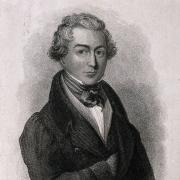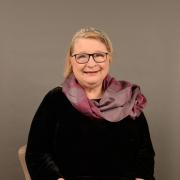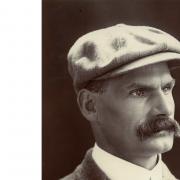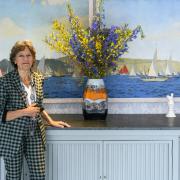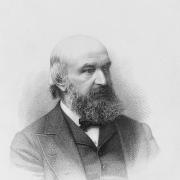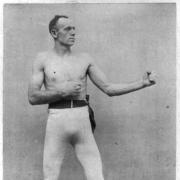Born Mary Gertrude Johnstone in Saltash midway through WW1 on August 18, 1916, she was aptly the daughter of an army officer, Captain John Johnstone, who’d served in that conflict but found the return to civvy street a hard adjustment. It was her mother, Beatrice née Limpenny, who first taught her to play the piano. She was an interesting character; a multilingual piano teacher who’d once been a governess in St Petersburg. Mary meanwhile would go on to study in Belgium before winning a scholarship to the Royal Academy of Music in London and undergoing further training in Vienna. Mary would have two younger brothers.
The Reading-born conductor Basil Cameron (1884-1975) auditioned Mary who then made her concert debut for him at Harrogate (Yorks) in 1929 when she was still only twelve years of age. Yes, she was something of a prodigy. It was actually Cameron who suggested a nom-de-plume or stage name for Mary which saw her morph into Moura Lympany. Moura, being a more exotic Russian variant of Mary and a nod to her mother’s time there, and Lympany, a tweak on her mother’s maiden name of Limpenny.

Her London debut followed in 1935 and in 1938 she was runner-up at the Queen Elisabeth Piano Competition in Brussels, which was named after Queen Elisabeth of Belgium, following which she completed a performing tour of Europe. She finished second out of 79 with 29 countries represented, a performance that so impressed the Belgian king, Leopold, that he asked her round for lunch. She made her debut at Milan’s famous La Scala in 1939.
By the time WW2 came around she was one of the most popular pianists in the UK, pretty good going for someone still only in their early-20s. As the Phoney War drew to a close Moura, as she now was, performed the British premiere of Aram Khachaturian’s Piano Concerto in D-flat, a piece that she would make her own. In fact, the war played a prominent part in Lympany’s early career as she became the first British musician to perform in Paris after the liberation with Chester’s Adrian Boult conducting.

Although the six years of conflict had undoubtedly slowed her career progression, Moura played concerts in Britain to help the war effort. Her routine, established and repeated ad infinitum, was to practice for four hours a day. Moura said she always sang the music in her head. Despite her popularity some critics refused to take Moura seriously, mistaking her undoubted glamour for a lack of earnestness.
Before the war ended, in 1944, Lympany had married fellow pianist, albeit of the amateur persuasion, engineering firm MD and keen gardener Lt. Colin Defries who was more than 30 years older. It was a marriage that only lasted until 1950. The following year Lympany married for a second time to US TV executive Bennet Korn, moving to the States where sadness stalked with two miscarriages, including a pair of twins, and a child dying shortly after birth scuppering hopes of a family. Moura would be divorced again in 1961.

After the war Moura took on the persona of a globetrotter as she performed in far-flung climes, everywhere from Europe, Canada and the US, where she first appeared in 1948, to India, Australia and New Zealand. She was much in demand. Her appearance at Carnegie Hall, New York, in November 1957, was followed by a review in the Los Angeles Herald & Express in which she was bracketed among ‘the few women pianists who could be counted among the great’. Moura accumulated so many air miles she was inducted into the Royal Aero Club as an honorary member.
In 1948 Moura was made a Fellow of the Royal Academy of Music. She’d become a close friend of the future Prime Minister, budding musician and yachtsman Ted Heath. In his autobiography Heath recalled how he bought a Steinway grand piano with some prizemoney that came his way in the Spring of 1963. It was Moura Heath consulted to help him choose one. He described her as ‘the distinguished concert pianist and a dear friend’. They toured London’s piano stores together, Moura ‘playing to demonstrate every aspect of each instrument’s capabilities to me’. Once chosen ‘Moura and I whiled away many happy hours together playing it at my flat’.

Further tragedy struck her in 1969 when she underwent a mastectomy but like the trooper she was, performed a Sergei Prokofiev piano concerto just three months later at London’s Royal Festival Hall. Despite a second mastectomy, Moura continued performing, her popularity as strong as ever. In 1979, 50 years after that Harrogate debut, she performed at the Royal Albert Hall in front of Charles, the then Prince of Wales. In the same year she was honoured with a CBE and was also sufficiently famous to become a ‘castaway’ on ‘Desert Island Discs’ (July 1979), excelling herself by choosing eight of her own recordings. Her book choice was one about growing fruit and veg whilst her luxury item was wine from her own vineyard.
From the early to mid-1980s Moura was based in Monaco, with ‘Moura – Her Autobiography’ published in 1991; although her lifestyle was always somewhat nomadic even at this more settled stage in her life. The following year Moura became a Dame. Moura was back in England on July 18, 1996 when she was a guest at a dinner party hosted by then Prime Minister John Major and his wife in honour of her friend Ted Heath who’d celebrated his 80th birthday earlier that month. H.M. Queen Elizabeth II and the Duke of Edinburgh were guests of honour and Moura joined some other notables from the world of music including Yehudi Menuhin and Susana, the widow of composer William Walton. Moura celebrated her own 80th birthday in August, receiving Portugal’s highest honour, the Medal and Cross of Prince Henry the Navigator, but also deciding to retire from the piano having played in Japan for the first time.
Dame Moura Lympany died in France on March 28, 2005 aged 88. She was a most versatile concert pianist with more than 60 different works in her repertoire and the first great woman pianist to specialise in the works of Sergei Rachmaninoff.
CHRONOLOGY
1916 – Mary Gertrude Johnstone born in Saltash (August 18).
1929 – 12-year-old Mary (Moura) makes her concert debut in Harrogate.
1938 – Runner-up at the Queen Elisabeth Piano Competition in Brussels.
1944 – Moura’s first marriage to Lt. Colin Defries (divorced 1950).
1951 – Moura marries for a second time to US TV executive Bennet Korn.
1963 – Moura helps Ted Heath choose his Steinway Grand Piano.
1979 – Performs at the Royal Albert Hall in front of Prince Charles.
1991 – Publication of Moura Lympany’s autobiography.
1992 – Moura becomes a Dame having previously been made a CBE.
2005 – Death of Dame Moura Lympany in France (March 28) aged 88.
















